The AMD Threadripper 2990WX 32-Core and 2950X 16-Core Review
by Dr. Ian Cutress on August 13, 2018 9:00 AM ESTThermal Comparisons and XFR2: Remember to Remove the CPU Cooler Plastic!
Every machine build has some targets: performance, power, noise, thermal performance, or cost. It is certainly hard to get all of them, so going after two or three is usually a good target. Well it turns out that there is one simple error that can make you lose on ALL FIVE COUNTS. Welcome to my world of when I first tested the 32-core AMD Ryzen Threadripper 2990WX, where I forgot to remove the plastic from my CPU liquid cooler.
Don’t Build Systems After Long Flights
Almost all brand new CPU coolers, either air coolers, liquid coolers, or water blocks, come pre-packaged with padding, foam, screws, fans, and all the instructions. Depending on the manufacturer, and the packaging type, the bottom of the CPU cooler will have been prepared in two ways:
- Pre-applied thermal paste
- A small self-adhesive plastic strip to protect the polishing during shipping
In our review kit, the Wraith Ripper massive air cooler, made by Cooler Master but promoted by AMD as the ‘base’ air cooler for new Threadripper 2 parts, had pre-applied thermal paste. It was across the whole base, and it was thick. It made a mess when I tried to take photos.
Also in our review kit was the Enermax Liqtech TR4 closed loop liquid cooler, with a small tube of thermal paste included. The bottom of the CPU block for the liquid cooler was covered in a self-adhesive plastic strip to protect the base in the packaging.
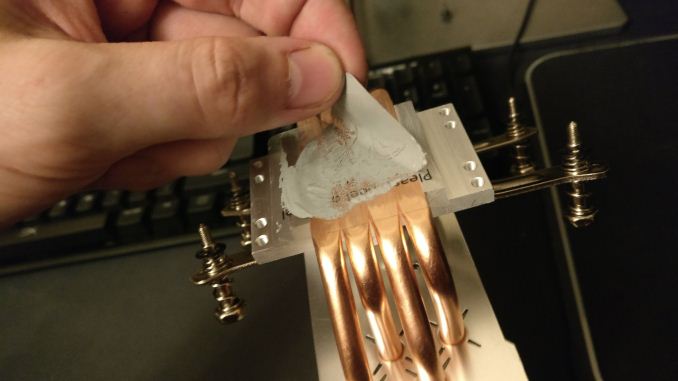
Example from TechTeamGB's Twitter
So confession time. Our review kit landed the day before I was travelling from the UK to San Francisco, to cover Flash Memory Summit and Intel’s Datacenter Summit. In my suitcases, I took an X399 motherboard (the ASUS ROG Zenith), three X399 chips (2990WX, 2950X, 1950X), an X299 motherboard (ASRock X299 OC Formula), several Skylake-X chips, a Corsair AX860i power supply, an RX 460 graphics card, mouse, keyboard, cables – basically two systems and relying on the monitor in the hotel room for testing. After an 11 hour direct flight, two hours at passport control, a one hour Uber to my hotel, I set up the system with the 2990WX.
I didn’t take off the plastic on the Enermax cooler. Well, I didn’t realize it at the time. I even put thermal paste on the processor, and it still didn’t register when I tightened the screws.
I set the system up at the maximum supported memory frequency, installed Windows, installed the security updates, installed the benchmarks, and set it to run overnight while I slept. I didn’t even realize the plastic was still attached. Come mid-morning, the benchmark suite had finished. I did some of the extra testing, such as base frequency latency measurements, and then went to replace the processor with the 2950X. It was at this time I performed a facepalm.
It was at that point, with thermal paste all over the processor and the plastic, I realized I done goofed. I took the plastic off, re-pasted the processor, and set the system up again, this time with a better thermal profile. But rather than throw the results away, I kept them.
Thermal Performance Matters
The goal of any system is to keep it with a sufficient thermal window to maintain operation: most processors are rated to work properly from normal temperatures up to 105C, at which point they shut down to avoid permanent thermal damage. When a processor shuttles electrons around and does things, it consumes power. That power is lost as heat, and it dissipates from the silicon out into two main areas: the socket and the heatspreader.
For AMD’s Threadripper processors, the thermal interface material between the silicon dies and the heatspreader is an indium-tin solder, a direct metal-to-metal bonding for direct heat transfer. Modern Intel processors use a silicone thermal grease instead, which is not as great, but has one benefit – it lasts longer through thermal cycling. As metals heat up, they expand: with two metals bonded together, with different thermal expansion coefficients, with enough heat cycles will crack and be ineffective – thermal grease essentially eliminates that issue. Thermal grease also happens to be cheaper. So it’s a trade-off between price/longevity and performance.
Above the heatspreader is the CPU cooler, but between the two is another thermal interface which the user can decide. The cheapest options involve nasty silicone thermal grease that costs cents per gallon, however performance enthusiasts might look towards a silver based thermal paste or a compound with good heat transfer characteristics – usually the ability for a paste to spread under pressure is a good quality. Extreme users can implement a liquid metal policy, similar to that of the solder connection, which binds the CPU to the CPU cooler pretty much permanently.
So what happens if you suddenly put some microns of thermally inefficient plastic between the heatspreader and the CPU cooler?
First of all, the conductive heat transfer is terrible. This means that the thermal energy stays in the paste and headspreader for longer, causing heat soak in the processor, raising temperatures. This is essentially the same effect when a cooler is overwhelmed by a large processor – heat soak is real and can be a problem. It typically leads to a runaway temperature rise, until the temperature gradient can equal the heat energy output. This is when a processor gets too hot, and typically a thermal emergency power state kicks in, reducing voltage and frequency to super low levels. Performance ends down the drain.
What does the user see in the system? Imagine a processor hitting 600 MHz while rendering, rather than a nice 3125 MHz at stock (see previous page). Base temperatures are higher, load temperatures are higher, case temperatures are higher. Might as well dry some wet clothes in there while you are at it. A little thermal energy never hurt a processor, but a lot can destroy an experience.
AMD’s XFR2
Ultimately this issue hurts AMD more than you might think. The way AMD implements its turbo modes is not a look-up-table where cores loaded equals turbo frequency – it relies on power, current, and thermal limits of a given chip. Where there is room, the AMD platform is designed to add frequency and voltage where possible. The thermal aspect of this is what AMD calls XFR2, or eXtended Frequency Range 2.
At AMD’s Tech Day for Threadripper 2, we were presented with graphs showing the effects of using better coolers on performance: around 10% better benchmark results due to having higher thermal headroom. Stick the system in an environment with a lower ambient temperature as well, and AMD quoted a 16% performance gain over a ‘stock’ system.
However, the reverse works too. By having that bit of plastic in there, what this effectively did was lower that thermal ceiling, from idle to load, which should result in a drop in performance.
Plastic Performance
So despite being in a nice air-conditioned hotel room, that additional plastic did a number on most of our benchmarks. Here is the damage:
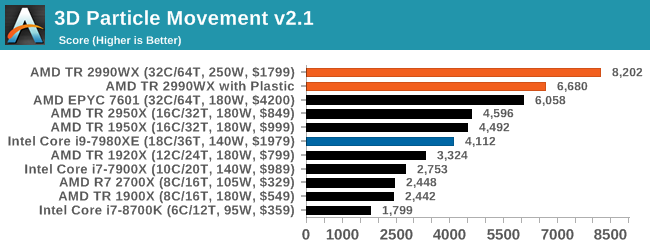
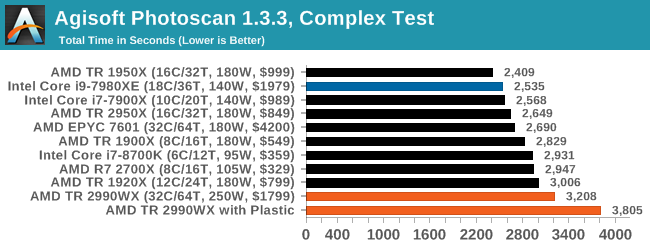
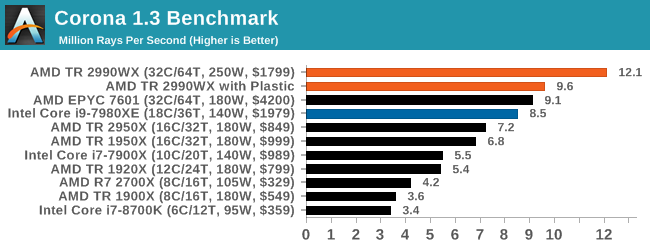
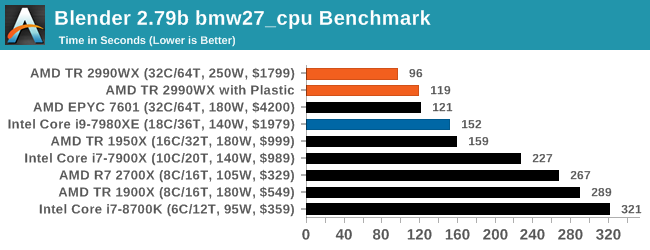
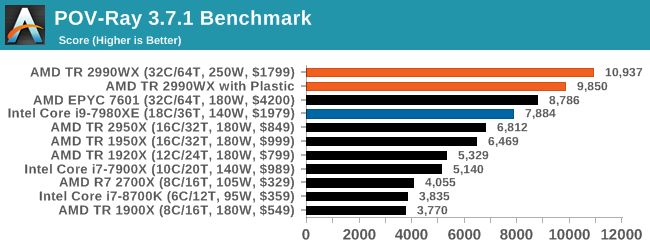

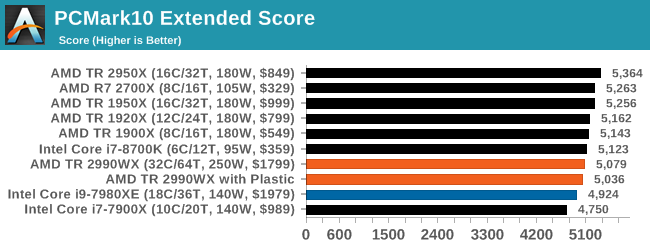
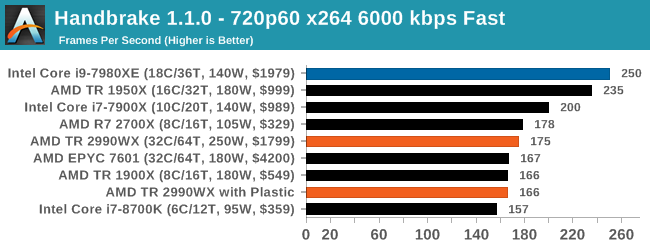
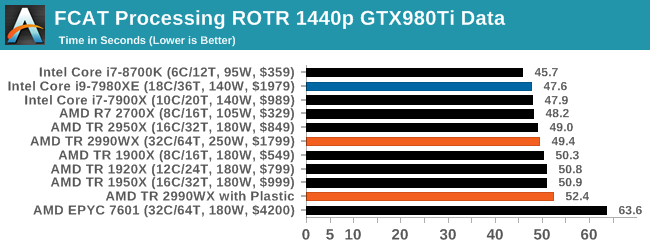
For all of our multi-threaded tests, where the CPU is hammered hard, there is a significant decrease in performance as expected. Blender saw a 20% decrease in throughput, POV-Ray was 10% lower, 3DPM was 19%. PCMark was only slightly lower, as it has a lot of single threaded tests, and annoyingly in some benchmarks we saw it swing the other way, such as WinRAR, which is more DRAM bound. Other benchmarks not listed include our compile test, where the plasticated system was 1% slower, or Dolphin, where there was a one-second difference.
What Have I Learned?
Don’t be a fool. Building a test bed with new components when super tired may lead to extra re-tests.





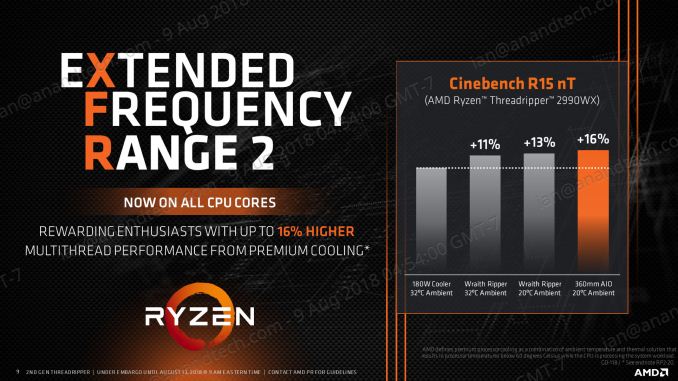








171 Comments
View All Comments
3DVagabond - Wednesday, August 15, 2018 - link
When did you switch to this new benchmark suite?Lord of the Bored - Wednesday, August 15, 2018 - link
Still writing...mukiex - Friday, August 17, 2018 - link
Looks like it's no longer a problem! They deleted all those pages.GreenReaper - Saturday, August 18, 2018 - link
They're back again now.abufrejoval - Wednesday, August 15, 2018 - link
Separating CPU (and GPU) cores from their memory clearly doesn't seem sustainable going forward.That's why I find the custom chip did for the chinese console so interesting: If they did an HBM variant, perhaps another with 16 or even 32GB per SoC, they'd use the IF mostly for IPC/non-local memory access and the chance of using GPGPU compute for truly parallel algorithms would be much bigger as the latency of context switches between CPU and GPU code would be minimal with both using the same physical memory space.
They might still put ordinary RAM or NV-RAM somewhere to the side as secondary storage, so it looks a little like Knights Landing.
IF interconnects might be a little longer, really long when you scale beyond what you can fit on a single board and probably something where optical interconnects would be better (once you got them...)
I keep having visions of plenty of such 4x boards swimming immersed in a tank of this "mineral oil" stuff that evidently has little to do with oil but allows so much more density and could run around those chips 'naked'.
Alaa - Wednesday, August 15, 2018 - link
I do not think that testing only a single tool at a time is a good benchmark for such high core count architecture. These cores need concurrent workloads to showcase their real power.csell - Thursday, August 16, 2018 - link
Can somebody please tell me the difference between the ASUS ROG Zenith Extreme motherboard rev 2 used here and the old ASUS ROG Zenith Extreme motherboard. I can't find any information about the rev 2 somewhere else?UnNameless - Friday, August 17, 2018 - link
I also want to know that. I have the "rev 1" Asus rog zenith extreme and can't find any difference.spikespiegal - Friday, August 17, 2018 - link
Companies buy PC's to run applications and don't care about memory timing, CPU's, clock speed or any other MB architecture. They only care about the box on the desk to run applications and ROI, as they should. AMD has historically only made a dent in the low end desktop market because Intel has this funny habit of not letting chip prices depreciate much below $200. AMD does, so they occupy the discount desktop market because when you buy 10,000 general purpose workstations saving $120 per box is a big chunk of change.I'm looking at the benchmark tests and all I'm seeing is the AMD chips doing well in mindless rendering and other synthetic desktop tasks no one outside multimedia would care about. The i7 holds it's own in too many complex application tests, which proves that once again per core efficacy is all that matters and AMD can't alter the reality of this. Where is the VMware host / mixed guest application benchmark consisting of Exchange, SQL, RDS, file services, AD and other? You know, those things that run corporate commerce and favor high core efficacy? Nobody runs bare metal servers anymore, and nobody reputable builds their own servers.
Dragonrider - Friday, August 17, 2018 - link
Ian, are you going to test PBO performance with these processors (I know, it was probably not practical while you were on the road)? Some questions popped up in my mind. Can PBO be activated when the processor in partial mode (i.e. 1/2 mode or game mode in the case of the 2990)? Also What does the power consumption and performance look like in those partial modes for different application sets with and without PBO? I know that represents a lot of testing, but on the surface, the 2990 looks like it could be a really nice all-round processor if one were willing to do some mode switching. It seems like it should perform pretty close to the 2950 in game mode and 1/2 mode and you have already established that it is a rendering beast in full mode. Bottom line, I think the testing that has been published so far only scratches the surface of what this processor may be capable of.